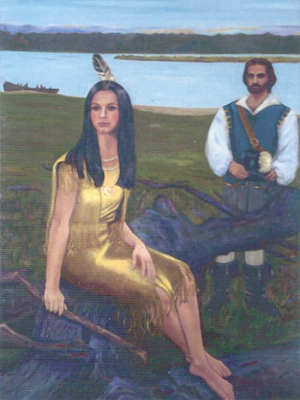 Our “Leedstown on the Rappahannock” portrait pictures John Smith and Pocahontas, though they never met at this site, they each have a Leedstown story.
Our “Leedstown on the Rappahannock” portrait pictures John Smith and Pocahontas, though they never met at this site, they each have a Leedstown story.
In 1608, John Smith exploring the river with a party including six soldiers and six gentlemen, landed at King Passesseck’s village site, now, Leedstown. This is the first recorded footsteps of the English on what is now Westmoreland County. Smith’s written report states that the natives treated them kindly. He further states that it pleased God to take one of the Gentlemen, Richard Featherstone. They buried him on the shore of the wide area of the river, which they named Featherstone Bay.
In February 1613, Pocahontas left her father Powhatan and their village on the York River to visit the Potomac Tribe. It is suggested that she very probably traveled overland by the shortest route, visiting Powhatan’s confederate villages along the way.
If this is true, she would have crossed the Rappahannock to King Passesseck’s village, and used ancient trails and shortest route across the Northern Neck to the Potomac.
Captain Samuel Argall learning of Pocahontas’s visit to the Potomac tribe immediately sailed his ship “Adventurer” up the river. With the help on an Indian accomplice they tricked Pocahontas aboard and set sail for Jamestown with her in captivity. She was held hostage in order to persuade Powhatan to be more tractable in his dealings with the colony.
While in captivity, Pocahontas met John Rolph, a widower. They were married in April 1614. In 1616 with their infant son, they sailed for England where Pocahontas was presented to English society as a princess. Before her return to Virginia in 1617, Pocahontas died of an “unexpected illness” and was buried at Gravesend on the coast of England.
